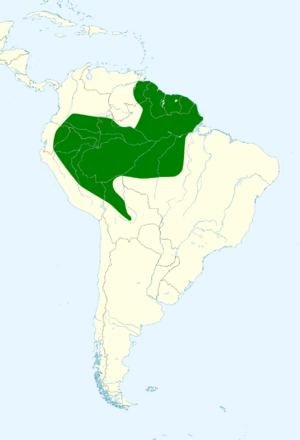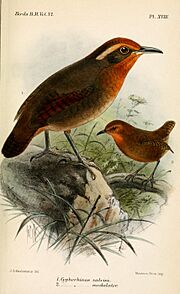Musician wren facts for kids
Quick facts for kids Musician wren |
|
|---|---|
 |
|
| At Presidente Figueiredo, Amazonas, Brazil | |
| Conservation status | |
| Scientific classification | |
| Genus: |
Cyphorhinus
|
| Species: |
arada
|
 |
|
| Synonyms | |
|
|
The musician wren is a small bird known for its amazing songs. People sometimes call it the organ wren because its songs sound so beautiful. This bird lives in the Amazon rainforest in South America. You can find it from the lowlands up to the base of the Andes mountains.
Contents
About the Musician Wren
The musician wren is a type of wren. It is famous for its very special and complex songs. These songs are why it got its name.
Different Kinds of Musician Wrens
Scientists group animals into different types. The musician wren (Cyphorhinus arada) is closely related to the song wren. They might have once been considered the same bird.
There are six different kinds, or subspecies, of the musician wren. They look a little different and sing slightly different songs. Some scientists even think each of these six types should be its own species!
The six main types are:
- C. a. arada
- C. a. griseolateralis
- C. a. interpositus
- C. a. transfluvialis
- C. a. salvini
- C. a. modulator
What They Look Like
The musician wren is about 12.5 cm (4.9 in) long. It weighs between 18 to 24 g (0.63 to 0.85 oz), which is about as much as a few quarters.
The main type of musician wren has a reddish-brown head. This color gets darker towards the back of its head. It has a light, thin stripe above its eye. There is also a dark stripe behind its eye. Its cheeks are orange-brown.
A wide "collar" of black and white stripes goes around its neck and upper back. The lower back is a reddish-brown. Its tail is medium brown with thin darker stripes.
The bird's chin, throat, and upper chest are a bright orange-brown. This color changes sharply to a pale, light brown on its lower chest and belly. Its sides and lower belly are yellowish-brown. Young musician wrens look similar to adults.
How Subspecies Differ
- C. a. griseolateralis has a thinner collar and looks grayer underneath.
- C. a. interpositus does not have the collar and has brownish-gray cheeks.
- C. a. transfluvialis is smaller and lighter in color.
- C. a. salvini also lacks the collar and is very dark all over.
- C. a. modulator is similar to transfluvialis but has a wider stripe above its eye. Its upper parts are also lighter.
Where They Live
Musician wrens live in different parts of the Amazon rainforest. Each subspecies lives in a specific area:
- C. a. arada lives in eastern and southeastern Venezuela, the Guianas, and northeastern Brazil.
- C. a. griseolateralis is found in Brazil. It lives on the south bank of the lower Amazon River.
- C. a. interpositus lives in north-central Brazil. It is found between the Madeira and Tapajós rivers.
- C. a. transfluvialis lives from the foothills of Colombia's Andes mountains to the Rio Negro in northwestern Brazil.
- C. a. salvini is found in southern Colombia, eastern Ecuador, and northeastern Peru.
- C. a. modulator lives in eastern Peru, northern Bolivia, and western Brazil.
These wrens usually live in the lower parts of wet forests. In Brazil, they can also be found in várzea forests, which are flooded seasonally. They mostly live from sea level up to 500 m (1,600 ft) high. Sometimes, they are seen as high as 1,000 m (3,300 ft). In Venezuela, they can even be found at 1,400 m (4,600 ft).
Musician Wren Behavior
What They Eat
Musician wrens mostly look for food on or near the ground. They search through leaves and other plant material. Their diet includes insects, spiders, and small crustaceans. They also eat berries.
These birds usually hunt in pairs or with their family. They sometimes follow swarms of army ants to catch insects that are disturbed. However, they usually do not join large groups of different bird species hunting together.
Life Cycle and Reproduction
Musician wrens have a long breeding season. It lasts from at least July to September. Their nest is shaped like a ball with a funnel-shaped entrance. They build it using leaf skeletons and coarse grass. A female musician wren usually lays two eggs.
Their Amazing Songs
Musician wren pairs often sing together. This is called "antiphonal" singing. They sing a series of clear, beautiful whistles. These whistles change a lot in how high or low they sound. Their regular call is a harsh sound, like "churk."
Conservation Status
The IUCN (International Union for Conservation of Nature) has listed the musician wren as a species of Least Concern. This means that scientists are not worried about it becoming endangered right now. It lives across a very large area. Much of its habitat is still untouched by humans. Also, it lives in several protected areas.



